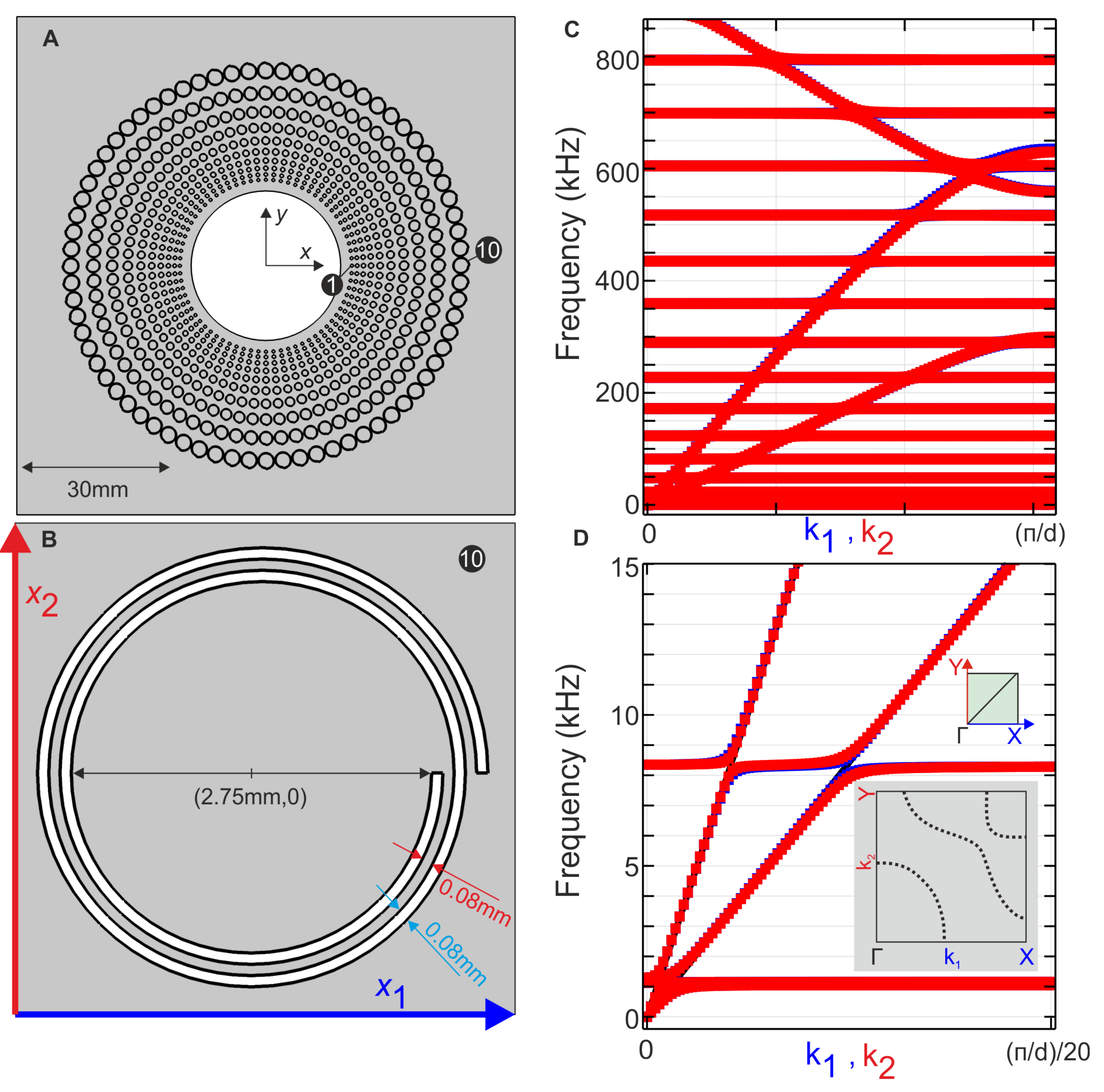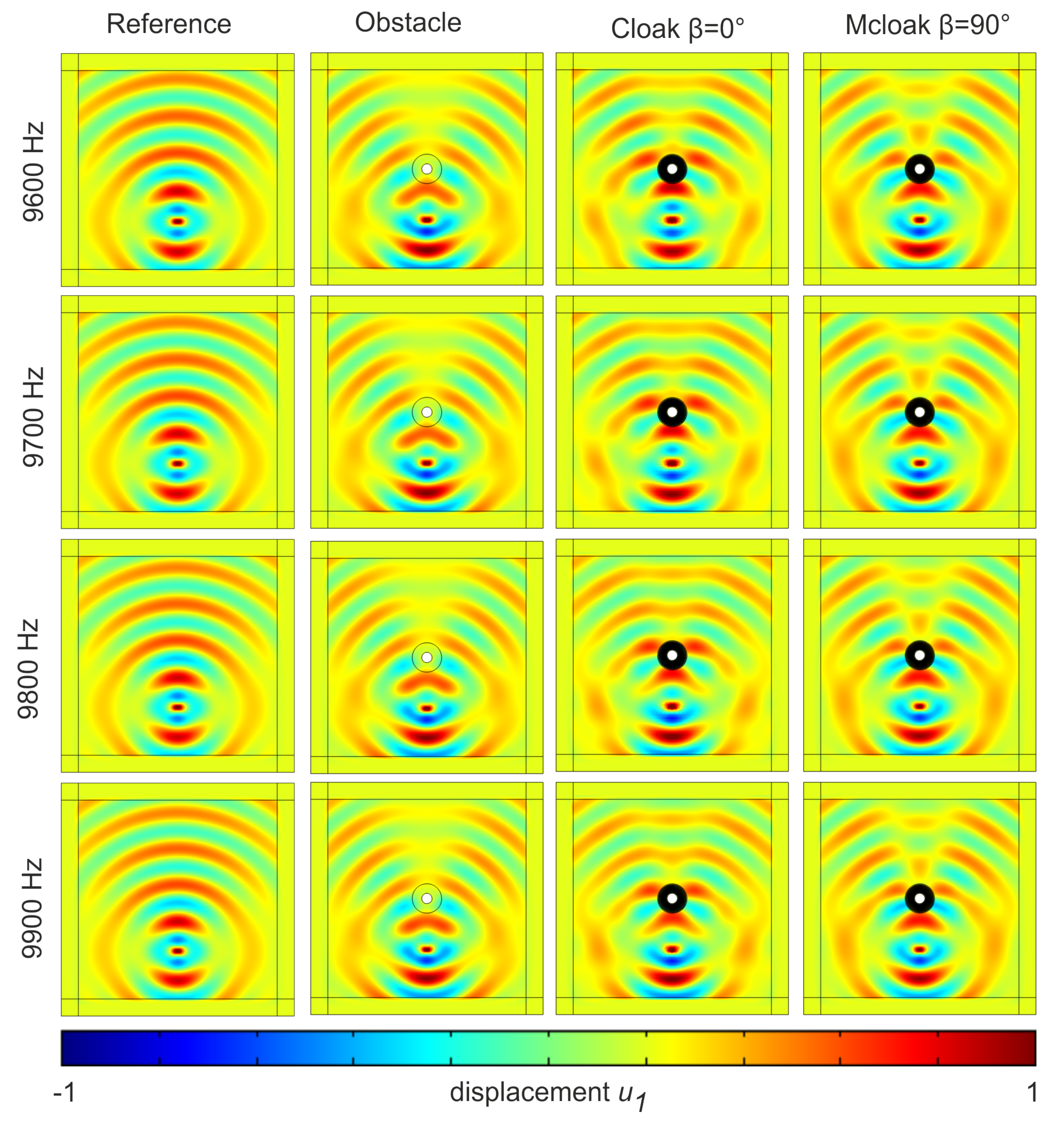Cloaking In-Plane Elastic Waves with Swiss Rolls
Abstract
1. Introduction
2. Transformed Willis Equations and Minor Symmetry Breaking
3. Periodic Medium with Stress-Free Swiss Rolls and Resonances
4. Effective Properties and Cloaking
5. Physical Discussion of Band Diagrams
6. Conclusions
Author Contributions
Funding
Conflicts of Interest
Appendix A. On Willis Medium with Cosserat Coefficients
References
- Milton, G.W.; Briane, M.; Willis, J.R. On cloaking for elasticity and physical equations with a transformation invariant form. N. J. Phys. 2006, 8, 248. [Google Scholar] [CrossRef]
- Brun, M.; Guenneau, S.; Movchan, A.B. Achieving control of in-plane elastic waves. Appl. Phys. Lett. 2009, 94, 061903. [Google Scholar] [CrossRef]
- Diatta, A.; Guenneau, S. Controlling solid elastic waves with spherical cloaks. Appl. Phys. Lett. 2014, 105, 021901. [Google Scholar] [CrossRef]
- Norris, A.; Shuvalov, A.L. Elastic cloaking theory. Wave Motion 2011, 48, 525–538. [Google Scholar] [CrossRef]
- McCall, M.; Pendry, J.B.; Galdi, V.; Lai, Y.; Horsley, S.A.R.; Li, J.; Zhu, J. Roadmap on transformation optics. J. Opt. 2018, 20, 63001. [Google Scholar] [CrossRef]
- Willis, J.R. Variational principles for dynamic problems for inhomogeneous elastic media. Wave Motion 1981, 3, 1–11. [Google Scholar] [CrossRef]
- Pendry, J.B. A new route to negative refraction. Science 2004, 306, 1353–1355. [Google Scholar] [CrossRef]
- Frenzel, T.; Kadic, M.; Wegener, M. Three-dimensional mechanical metamaterials with a twist. Science 2017, 358, 1072–1074. [Google Scholar] [CrossRef]
- Fernandez-Corbaton, I.; Rockstuhl, C.; Ziemke, P.; Gumbsch, P.; Albiez, A.; Schwaiger, R.; Frenzel, T.; Kadic, M.; Wegener, M. New twists of 3D chiral metamaterials. Adv. Mater. 2019, 31, 1807742. [Google Scholar] [CrossRef]
- Kadic, M.; Milton, G.W.; van Hecke, M.; Wegener, M. 3D metamaterials. Nat. Rev. Phys. 2019, 1, 198–210. [Google Scholar] [CrossRef]
- Kadic, M.; Diatta, A.; Frenzel, T.; Guenneau, S.; Wegener, M. Static chiral Willis continuum mechanics for three-dimensional chiral mechanical metamaterials. Phys. Rev. B 2019, 99, 214101. [Google Scholar] [CrossRef]
- Quan, L.; Radi, Y.; Sounas, D.L.; Alu, A. Maximum Willis Coupling in Acoustic Scatterers. Phys. Rev. Lett. 2018, 120, 254301. [Google Scholar] [CrossRef] [PubMed]
- Melnikov, A.; Chiang, Y.K.; Quan, L.; Oberst, S.; Alu, A.; Marburg, S.; Powell, D. Acoustic meta-atom with experimentally verified maximum Willis coupling. Nat. Commun. 2019, 10, 3148. [Google Scholar] [CrossRef]
- Russell, P.S.J.; Marin, E.; Diez, A.; Guenneau, S.; Movchan, A.B. Sonic band gaps in PCF preforms: Enhancing the interaction of sound and light. Opt. Express 2003, 11, 2555–2560. [Google Scholar] [CrossRef] [PubMed]
- Thomas, J. Vibration Characteristics of Tapered Cantilever Beams. Ph.D. Thesis, University of Surrey, Guildford, UK, 1968. Available online: http://epubs.surrey.ac.uk/848431/1/10803973.
- Zolla, F.; Nicolet, A.; Guenneau, S. Swiss roll lattices: Numerical and asymptotic modeling. Waves Random Complex Media 2007, 17, 571–579. [Google Scholar] [CrossRef]
- Sharma, G.S.; Skvortsov, A.; MacGillivray, I.; Kessissoglou, N. Acoustic performance of periodic steel cylinders embedded in a viscoelastic medium. J. Sound Vib. 2019, 443, 652–665. [Google Scholar] [CrossRef]
- Skvortsov, A.; MacGillivray, I.; Sharma, G.S.; Kessissoglou, N. Sound scattering by a lattice of resonant inclusions in a soft medium. Phys. Rev. E 2019, 99, 063006. [Google Scholar] [CrossRef]
- Nassar, H.; He, Q.C.; Auffray, N. A generalized theory of elastodynamic homogenization for periodic media. Int. J. Solids Struct. 2016, 84, 139–146. [Google Scholar] [CrossRef]
- Pendry, J.B.; Schurig, D.; Smith, D.R. Controlling electromagnetic fields. Science 2006, 312, 1780–1782. [Google Scholar] [CrossRef]
- Eringen, A. Elastodynamics; Academic Press: Cambridge, MA, USA, 1974. [Google Scholar]
- Eringen, A.C. Theory of Micropolar Elasticity. In Microcontinuum Field Theories; Springer: New York, NY, USA, 1999. [Google Scholar]
- Lindell, I.; Sihvola, A.; Tretyakov, S.; Viitanen, A. Electromagnetic Waves in Chiral and Bi-Isotropic Media; Artech House: Boston, MA, USA, 1994. [Google Scholar]
- Guenneau, S.; Zolla, F. Homogenization of 3D finite chiral photonic crystals. Phys. B 2007, 394, 145–147. [Google Scholar] [CrossRef]
- Achaoui, Y.; Diatta, A.; Guenneau, S. Steering in-plane shear waves with inertial resonators in platonic crystals. Appl. Phys. Lett. 2015, 106, 223502. [Google Scholar] [CrossRef]
- Bückmann, T.; Kadic, M.; Schittny, R.; Wegener, M. Mechanical cloak design by direct lattice transformation. Proc. Natl. Acad. Sci. USA 2015, 112, 4930–4934. [Google Scholar] [CrossRef] [PubMed]
- Kadic, M.; Wegener, M.; Nicolet, A.; Zolla, F.; Guenneau, S.; Diatta, A. Elastodynamic behavior of mechanical cloaks designed by direct lattice transformations. Wave Motion 2020, 92, 102419. [Google Scholar] [CrossRef]
- Nassar, H.; Chen, Y.Y.; Huang, G.L. A degenerate polar lattice for cloaking in full two-dimensional elastodynamics and statics. Proc. R. Soc. A 2018, 474, 20180523. [Google Scholar] [CrossRef]
- Zhang, H.K.; Chen, Y.; Liu, X.N.; Hu, G.K. An asymmetric elastic metamaterial model for elastic wave cloaking. J. Mech. Phys. Solids 2020, 135, 103796. [Google Scholar] [CrossRef]



© 2020 by the authors. Licensee MDPI, Basel, Switzerland. This article is an open access article distributed under the terms and conditions of the Creative Commons Attribution (CC BY) license (http://creativecommons.org/licenses/by/4.0/).
Share and Cite
Achaoui, Y.; Diatta, A.; Kadic, M.; Guenneau, S. Cloaking In-Plane Elastic Waves with Swiss Rolls. Materials 2020, 13, 449. https://doi.org/10.3390/ma13020449
Achaoui Y, Diatta A, Kadic M, Guenneau S. Cloaking In-Plane Elastic Waves with Swiss Rolls. Materials. 2020; 13(2):449. https://doi.org/10.3390/ma13020449
Chicago/Turabian StyleAchaoui, Younes, André Diatta, Muamer Kadic, and Sébastien Guenneau. 2020. "Cloaking In-Plane Elastic Waves with Swiss Rolls" Materials 13, no. 2: 449. https://doi.org/10.3390/ma13020449
APA StyleAchaoui, Y., Diatta, A., Kadic, M., & Guenneau, S. (2020). Cloaking In-Plane Elastic Waves with Swiss Rolls. Materials, 13(2), 449. https://doi.org/10.3390/ma13020449





